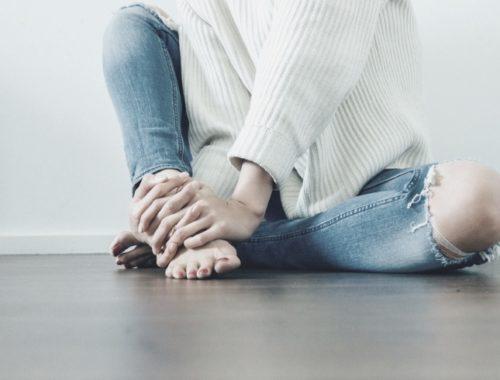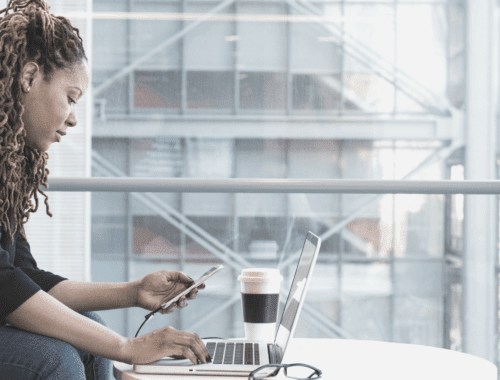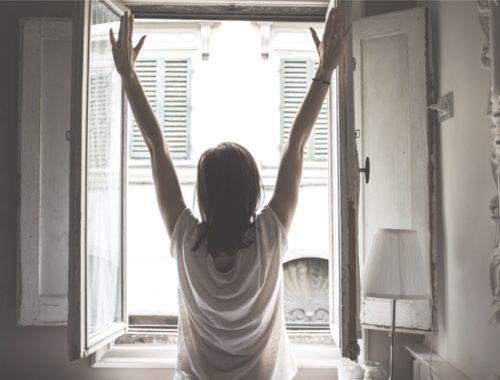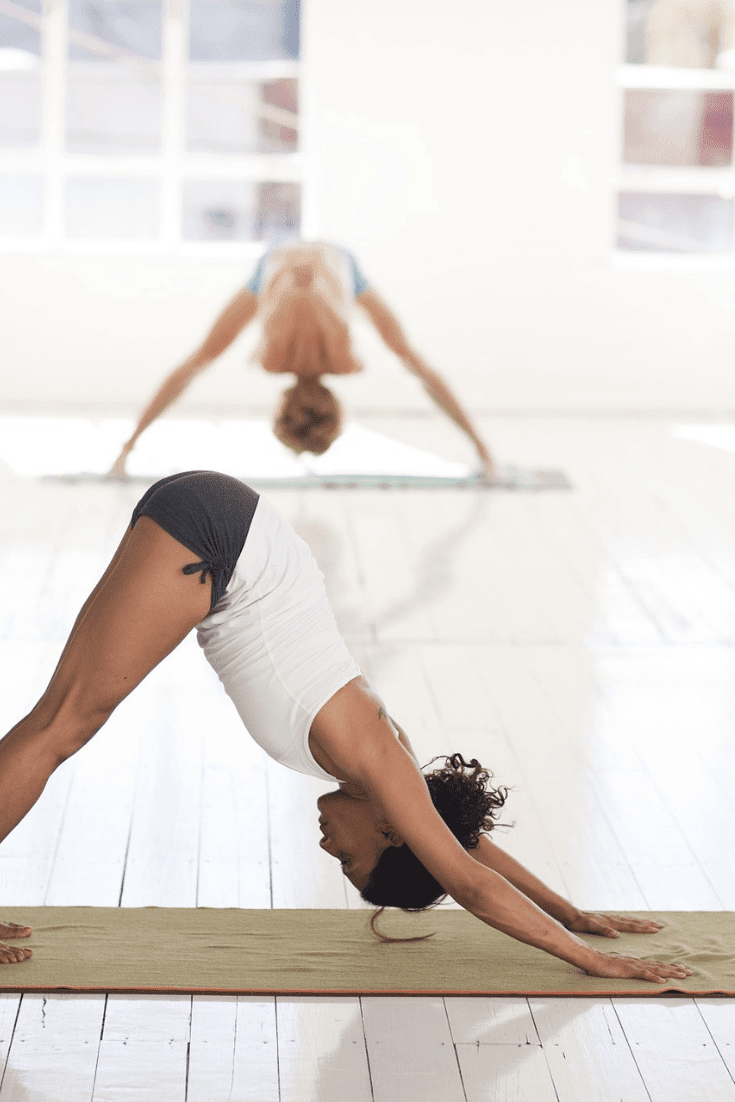
5 Ways to Boost Energy Levels Wearing the Oura Ring
Let’s face it. Life is amazing. It’s also a juggling act. And finding the balance isn’t always easy. As a lover of data and all things scientific and technical, I must confess that I’m usually one of the first to try out new ways of working and living. I trawl Kickstarter in my spare time. I read research articles on biohacking and longevity. Everyone does, right?
So when I heard about a wearable that can measure physiological signals from the body and bring the data together (hello, algorithm) to let me know how I was doing each day, I jumped at the chance. I’ve been wearing the Oura ring for three months now. Read on to hear what I’ve learned and how to boost your energy levels by diving into the data. Please note that I’m not affiliated with Oura in any way. I bought the ring as I was curious as to whether it would help me to adjust my habits to improve my well-being. These are my thoughts on the experience.
An Overview of the Oura Ring
The Oura ring is a physical ring that uses a 3D accelerometer, sensors, and a gyroscope to track body temperature, measure blood volume pulse, and detect the amplitude and intensity of body movement. It combines these metrics to evaluate the person’s state of readiness. It also provides tips and recommendations in the app.
Challenge yourself. Your readiness is strong and improving! Today’s a great day for setting new records.
Oura App tip from March 4th, 2019
I became interested in readiness after a challenging time when I wasn’t sleeping well. Sleep and how to get more of it is trending right now too.
What drew me to the Oura ring was its focus on providing deeper, more actionable data around sleep, stress, and recovery. It was all about feeling better. I was sold.
I bought the Balance Oura ring in silver color. It looks like a round wedding band with a slight point. Compared to my FitBit Blaze (which I still wear), the Oura has no blinking lights or other readouts, so it doesn’t interrupt my sleep with bright LED lights. It also lets you place it in airplane mode so that the Bluetooth functionality is disabled. The ring still collects the data but only syncs with the app when airplane mode is switched off.
I found wearing the ring was super comfortable. I wear it on my right ring finger and is so subtle that no one has ever commented about it until I take it off and show them the inside with the sensors and the app.
I’ve worn the ring when working out, including using the rowing machine and weights. No problems. Oura does warn that the ring could scratch, but so far, mine is still in great shape. I also wear the ring when washing my hands and in the shower.
Charging the ring is also super simple, although it is yet another charger to manage! The ring slips over a small charging stand port and fully charges in a matter of minutes. I’m finding this really convenient, as I can put the ring on charge when I’m taking a shower without feeling like I’m losing a lot of potential data.
What I Learned from Wearing the Oura Ring
One of my biggest learnings was that I could cultivate more energy and manage my life better by understanding my data. One of my favorite articles is called Manage Your Energy, Not Your Time.
In theory, I loved this. But in practice, it was always a challenge. I can measure my time. But how do I measure my energy aside from subjective feelings? This is where Oura’s readiness score really hit the mark for me. By building a readiness algorithm, they totally nailed the four pillars that Manage Your Energy, Not Your Time focuses on: physical energy, emotional energy, mental energy, and spiritual energy.
Physical Energy
By tracking my activity, I was able to see how this contributed to my readiness and how one fed the other. It gave feedback on my readiness, which was actually really smart.
I discovered a couple of interesting things in relation to my physical energy. During the weekends, when I am more active, my readiness score improves. But this seemed to work when I was active during the day mostly. I work out at Orange Theory Fitness in the evening during the week, but this leads to a raised heart rate later into the evening, and the Oura algorithm seems not to be as happy with a resting heart rate that decreases too late into the evening. Actually, the Recovery Index in Oura measures how long it takes for your resting heart rate to stabilize during the night. They say that a sign of very good recovery is that the resting heart rate stabilizes during the first half of the night and at least 6 hours before you wake up. This gives the body time to recover for the next day.
So for me, it’s quite a conundrum. Should I continue doing HIIT in the evening, especially when it affects my resting heart rate? Or should I celebrate the burst of activity and its contribution to my activity score?
Another thing I found interesting was just how well the Oura tracks my body’s physiological responses in different situations. For instance, in the first graph (this is taken from the Oura Cloud, although the app has amazing data, too), I was in a high state of readiness. My readiness score was 96, which was probably due to a great sleep score of 93 plus an activity score of 85. My resting heart rate was on the low end of my range, my average HRV was 55 ms (the maximum was 105), and my body temperature and respiratory rate were stable.
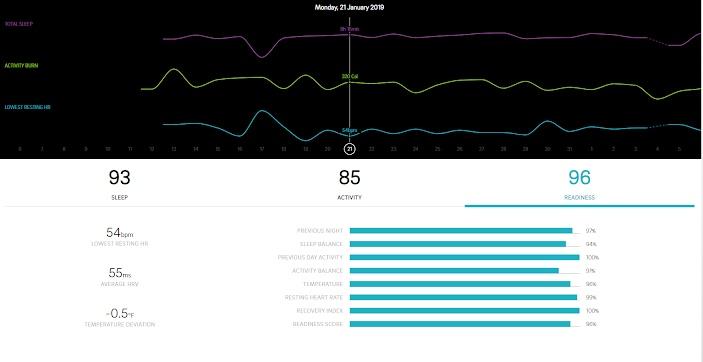
Compare this to another day when my readiness score was a dismal 57. My sleep score was 73 due to sleeping only 5 hours, my sleep balance (the amount of sleep over the past two weeks) was low as I’d been traveling a lot, and the previous night had only 46 minutes of REM sleep. My resting heart rate was 64 bpm (a full ten bpm higher than normal), and my average HRV was 33 ms (the maximum was 69).
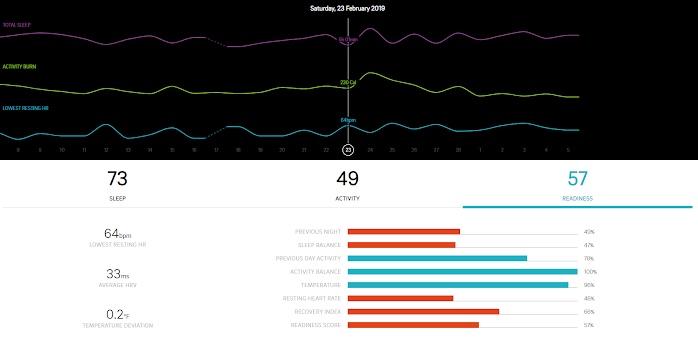
Emotional Energy
I started meditating about two years ago and, quite frankly, love it. Having awareness of the breath and clearing the mind, it adds to my productivity and a positive mindset. But I do have days where my brain has a lot of chatter. Even anxiety. Do you ever feel like this?
By measuring Heart Rate Variability (HRV), I’m able to validate the way my body and brain are feeling. HRV is a physiological parameter that you might not be familiar with.
Here’s the way I think about it. HRV is a pretty accurate measure of my Autonomic Nervous System (ANS), which response to how I exercise, recover, eat, sleep, and perceived stress. HRV isn’t the same as heart rate (which counts the number of heartbeats each minute). It looks at the changes (variability) in time between successive heartbeats.
With HRV, higher is better. Higher resting HRV signifies the ability of the body to activate the parasympathetic nervous system. You might have heard of this being called the “rest and digest” response. Higher HRV is correlated with:
- Improved health
- Higher fitness levels
- More resilience
- Calm and positive emotions.
Lower resting HRV indicates the sympathetic nervous system (“fight or flight”) has been activated, reducing the body’s ability to recover. This can be a response to chronic stress but also might be caused by a poor night’s sleep or a hard workout. Lower HRV has been linked to:
- Worsening health
- Reduced fitness levels
- Increased risk of inflammation and disease
- Negative emotions increase anxiety and depression.
My HRV tends to increase on the weekends and significantly decreases when I travel overseas. Although HRV is highly individual, I find that I feel great when it’s above 80 and out of sorts when it’s below 30. My HRV is definitely something I check every day. I use it to consciously think about what I need to do to improve it. This might include paying extra attention to slowing down my thoughts and reactions, listening to my body, and doing more deep breathing.
Mental Energy
I love being in flow. You might enjoy Mikhael Csikszentmehayi’s book of the same name, which you can either read in paperback or listen to the audiobook on Audible.
Some days I am able to have long stretches of deep and high-quality work. Other days, my brain struggles. This is where the sleeping score has helped me. I especially focus on my deep sleep. On days when I’ve had at least 1.5 hours of deep sleep, I feel invincible!
Deep sleep is the restorative and rejuvenating sleep stage that enables muscle growth and repair. You can probably tell when you’ve had plenty of deep sleep as you wake up feeling really refreshed, as during deep sleep, your blood pressure drops, heart and breathing rates are regular, and arm and leg muscles are relaxed. I also routinely check my REM (Rapid Eye Movement) sleep, which plays an important role in re-energizing your mind and body. It’s associated with dreaming, memory consolidating, learning, and creativity. REM is regulated by circadian rhythms, so getting a full night’s sleep and sticking to a regular sleep schedule can increase your chance of getting more REM.
This has become particularly important in understanding my need for recovery after travel and especially overseas travel with different time zones, jet lag, and poor sleep quality. I’m certainly being a little kinder to my body when my readiness score is low, avoiding deep thinking activities when my sleep score is low, and working out different ways to get through the day.
Spiritual Energy
I like to think of my spiritual energy as aligning my strengths with whatever I am attempting. Focusing on doing more of what I’m good at. Doing what I love. To be a high achiever, it is critical to prioritize based on values and dedicate time to this. These are the things that will bring the most fulfillment and increase energy.
It’s also important to have rest and relaxation. Warren Buffett famously has a nearly empty calendar, which gives him the flexibility to spend time thinking and strategizing rather than sitting in meetings all day. I found that looking at my HRV has become a good indicator of my spiritual energy. When my HRV is higher, I definitely feel more open to caring for my spiritual energy.
How to Boost Your Energy Levels
So, how do I get myself into a high-performance state and stay there? Here are my 5 tips that might be helpful to keep you consistent with your energy outputs:
1. Prioritize your Sleep Hygiene
Sleep hygiene refers to habits that help you have a good night’s sleep. Having experienced insomnia and downright difficult sleeping patterns at times (including the dreaded 2 am wake-up), I’ve come to realize that sleep is the number one game-changer to a life well-lived.
The first thing to do is to understand your data so that you can build a plan to improve your sleep. I’m going to go out on a limb and say that the Oura ring probably has the best sleep tracker I’ve ever used. I’ve worn the Fitbit and the Apple Watch. I’ve used apps such as Sleep Cycle, which can track your sleep either by your phone sitting beside your bed or using the accelerometer and placing it under your pillow.
What I loved about the Oura is the way it provides a detailed breakdown of the different sleep phases. It considers both the total sleep and also efficiency, restfulness, REM sleep, deep sleep, latency, and timing. It’s really interesting how Oura thinks about these seven sleep contributors.
Timing of when you go to sleep, for instance, is important as many of your body’s essential processes, such as body temperature, hormone release, and hunger, operate according to the body’s circadian rhythms. I know when I’m traveling overseas, my sleep gets pretty messed up. This is because the body is designed to sleep during the night and stay awake and active during the day. But when I’m on the other side of the world (I’m writing this post from India, so my body is completely upside down right now), these internal rhythms go out of balance.
Latency refers to the amount of time it takes to actually fall asleep. On nights when I’m struggling to fall asleep, I use binaural beats or even nature sounds on Alexa to fall asleep faster.
2. Think about the Fuel You Put in Your Body
I’m not going to convince you which nutritional plan is right for you. Believe me, I’ve tried every one. What I would say is probably what you already know. Understand what your body reacts well to, eat healthy fats and proteins, and reduce your reliance on caffeine and sugars.
Self-mastery comes into play when you can identify what makes your body perform well and what to stay away from. This is probably one of the biggest challenges for most of us, and I’ve written an article here about how I manage to feed my children well, even when they have activities out of the house every day of the week.
From a personal perspective, I always start my day with a smoothie with a balance of proteins, fat, fiber, and greens. There are a lot of resources on the benefits of starting your day with smoothies. I love Be Well by Kelly and her Fab-4 smoothies, and Jen over at A Cure for Monday also has some great recipes. I’ve even worked out how to make my own smoothie packets to take on the road. I start with a large mason jar and add:
- Powdered greens – I like the Beauty Elixir by Amazing Grass as it also has adaptogens like moringa, ashwagandha, reishi, cordyceps, schisandra, and mucuna.
- Raw organic cacao – I order this in bulk from Healthworks as cacao powder is a great source of magnesium, calcium, zinc, iron, copper, and potassium.
- Grass-fed collagen for protein – I try and avoid dairy and have found the Vital Proteins in the blue jar to work in both cold and hot liquid.
- Flax for fiber – although you could also use chia or acacia. The flax I normally buy can be found here.
- MCT oil or almond butter.
These smoothies double as a hot chocolate when I add hot water, so have a feeling of luxury and indulgence. Nutritionally, the smoothie has about 250 calories and 18% carbohydrates, 48% fat, and 34% protein. When I travel, I will even bring my mason jar and smoothie packets so that I just need to ask for some hot water and can avoid temptations from being on the road.
3. Use Movement to Build Energy
It’s clear that you need to put your health and energy ahead of all else in order to make a difference in your life. Now I’ll confess, this is still a challenge for me, as I shared with my Oura activity data. Since I’ve worn the Oura ring, my activity score has ranged between 33% and 97% of Oura’s minimum daily activity goal, which is based on age, gender, and daily readiness. As I mentioned earlier, I’ve tended to prioritize sleep over activity, but clearly, all of this impacts my readiness.
On days when my activity is higher, I definitely see positive impacts. Even walking increases energy levels by 150%, and moderate-intensity exercise for 20 minutes increases the mood for more than 12 hours.
4. Find Habits that Work for You
The best use of an hour is to invest it in something that will continue to grow. When you invest time in the growth of another person, you are yielding a greater return than just spending it on yourself. Indeed, research has shown that athletes who break world records have an ethnocentric mindset where they focus on the impact on others, not just themselves.
If you just focus on yourself, it is hard to be energized. The moment you focus on others, everything shifts.
So let’s think about this in the context of habits. Stay focused on doing what is important every day. One of the things I’ve done has been to focus on new habits for an amount of time, then build on them to keep them going. Here are the 10 habits I love the most: wake up early, journal, meditate, move every day, build morning and night time routines, eat more vegetables, read every day, drink more water, learn something new, and remove clutter from your life.
5. Manage Your Reactions
How you react to what happens in your life today predicts chronic health conditions for a decade into the future, independent of your current health and future stress.
Ask yourself, “What is happening with my physiology when I am feeling low?”, “What is happening when I feel happy?”. You can reframe major stressors by being aware of the stress, looking for the meaning behind it, and channeling the stress to add motivation and increase productivity.
You can also change the energy. Do something to interrupt the pattern. Take a cold shower. Meditate. Go for a quick sprint or even trying rebounding. Changing your energy gets you into a new state.
Key Takeaways
Through the measurement of physiological signals and combining these into an algorithm, the Oura ring provides deep, actionable data on sleep, stress, and recovery. Looking at the data every day gives great feedback to help make lifestyle changes to improve energy.
The wearable ring and accompanying app are beautifully designed and crafted, making it a joy to take the tips and recommendations and change habits.
How do you boost your energy levels? Do you rely on data or use other methods to know how your body is doing?




